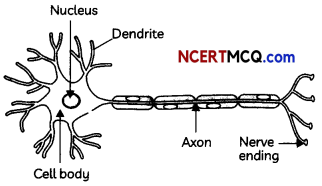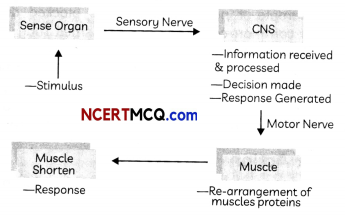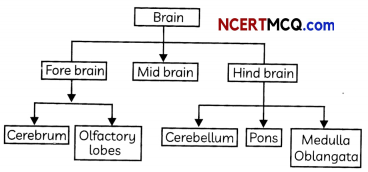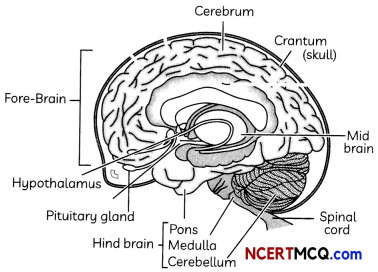Nervous System in Animals
Imagine that bright Light is focussed on our eyes or we touch a hot object We are able to detect the change and respond to it with movement in order to protect ourselves. All this movement, in response to the environment, is carefully controlled as the movement to be made depends upon the event that triggers it All living organisms must use systems providing control and coordination and they must have specialized tissues to provide these control and coordination activities.
In animals, control and coordination are provided by nervous and muscular tissues. All information from our environment is detected by the specialized tips of some nerve cells. These receptors are usually located in our sense organs, such as the inner ear, the nose, the tongue, and so on.
The nervous system includes the brain, spinal cord, and nerves. It controls and coordinates various func¬tions in the body. Its functions are:
- It receives information from the surroundings, processes and interprets it, and responds accordingly.
- It passes information from one internal system to another.
Sense organs: Sense organs or receptors are specialized structures through which animals receive a variety of external information. These are:
- Photoreceptors for light
- Photoreceptors for sound
- Olfactory receptors for smell
- Gustatory receptors for taste
Sensory neurons: These are the special type of nerve cells through which the receptors pass information to the brain.
![]()
Neuron
A neuron is the structural and functional unit of the nervous system and is the largest cell found in the body. A neuron has three components:

Structure of a neuron
Structure of a Neuron
- Cell body or Cyton: The cell body is like a typical cell containing nucleus and granular cytoplasm. Stimulus is changed into impulse in the cyton.
- Dendrites: Dendrites are short and branched processes connected to the cyton. They receive sensation or stimulus, which may be physical, chemical, mechanical or electrical. The stimulus is passed onto cyton.
- Axon: Axon is the longest part of the neuron. It is a single, elongated fibre arising from one side of cyton. It conducts impulses away from the cell body. The plasma membrane of an axon is covered by a protective sheath of lipid and protein called myelin sheath, formed by the Schwann cells.
Synapse: It is the functional junction between two adjacent neurons or nerve cells, i.e., between the axon ending of one neuron and the dendrites of the next.
Nerve Impulse
Nerve impulse is the information in the form of chemical and electrical signals passing through neurons. These impulses are carried by dendrites towards the cell body.
Nerve Impulse Travelling Through the Body
- The information, acquired at the end of the dendritic tip of a nerve cell, sets off a chemical reaction that creates an electrical impulse.
- This impulse travels from the dendrite to the cell body, and then along the axon to its end.
- At the end of the axon, the electrical impulse sets off the release of some chemicals.
- These chemicals cross the gap, or synapse, and start a similar electrical impulse in a dendrite of the next neuron.
Example 1.
What is the need for a system of control and coordination in an organism?
Answer:
All living organisms respond to changes in their environment for which they need a well organized system of control and coordination. At times we have controlled movement that must be connected to the recognition of various events in the environment, followed by only the correct movement in response to the stimulus. Specialised tissues are used to provide these control and coordination activities in multicellular organisms.
![]()
Example 2.
How do we detect the smell of an agarbatti (incense stick)?
Answer:
The smell of an agarbatti is detected by the olfactory receptors present in our nose which generate nerve impulses that reach the olfactory lobes present in the forebrain which produce the sensation of smell.
Example 3.
Case Based:
Put some sugar in your mouth. How does it taste? Block your nose by pressing it between your thumb and index finger. Now eat sugar again. Is there any difference in its taste? While eating lunch, block your nose in the same way and notice if you can fully appreciate the taste of the food you are eating.
(A) Identify the correct statements:
(I) Taste of sugar is sweet.
(II) Gustatory receptors in our tongue are responsible for taste.
(III) Olfactory receptors in our tongue are responsible for smell.
(IV) Receptors communicate information to the mouth so that we are able to taste things.
(a) Only (I)
(b) Both (I) and (II)
(c) (I), (II) and (III)
(d) (I), (III) and (IV)
Answer:
(b) Both (I) and (II)
Explanation: The taste of sugar is sweet. The taste is because of the combined perception of our sensory organs tongue and nose. Gustatory receptors in tongue and olfactory receptors in nose are responsible for taste and smell respectively. Both sensations are communicated to the brain, which integrates the information so that flavors can be recognized and appreciated.
(B) When we block our nose by pressing it between our thumb and index finger, then:
(a) There is no change in taste of sugar
(b) We do not get the taste of sugar
(c) There is a change in the taste of sugar
(d) Sugar tastes salty
Answer:
(c) There is a change in the taste of sugar
Explanation: Smell and taste are closely linked. The taste buds of the tongue identify taste, and the nerves in the nose identify smell. Gustatory receptors in tongue and olfactory receptors in nose are responsible for taste and smell respectively. Both sensations are communicated to the brain, which integrates the information so that flavors can be recognized and appreciated.
(C) Can you fully appreciate the taste of the food you are eating if you block your nose while eating lunch?
Answer:
No, we cannot fully appreciate the taste of the food we are eating if we block our nose while eating as the general perception of taste, which we have for any particular eatable substance, is jointly created by our sense organs tongue and nose through receptors. Gustatory receptors in tongue will detect taste while olfactory receptors in nasal cavity will detect smell.
(D) Loss of smell and taste is one of the early symptoms of COVID-19. Justify.
Answer:
Smell receptors can be temporarily damaged by the influenza (flu) virus or the Corona Virus. Some people cannot smell or taste for several days or even weeks after the virus attacks our body. Sudden loss of smell also may be an early symptom of corona virus disease 2019 (COVID-19), an acute respiratory illness that has taken so many lives in 2020-21.
(E) Assertion (A): The taste of food changes when we have blocked nose due to the common cold.
Reason (R): Gustatory receptors are responsible for taste
(a) Both (A) and (R) are true and (R) is the correct explanation of the (A).
(b) Both (A) and (R) are true, but (R) is not the correct explanation of the (A).
(c) (A) is true, but (R) is false.
(d) (A) is false, but (R) is true.
Answer:
(b) Both (A) and (R) are true, but (R) is not the correct explanation of the (A).
Explanation: When we have a blocked nose due to common cold, our ability to taste food changes due to the blockage of olfactory bulb which are the series of nerve endings in the nose, that not only allows to smell, but to taste at the same time. Gustatory receptors in tongue will detect taste while olfactory receptors in nasal cavity will detect smell.
The ability to smell can be affected by changes in the nose, in the nerves leading from the nose to the brain, or in the brain. For example, if nasal passages are blocked due to common cold, the ability to smell may be reduced because odors are prevented from reaching the smell receptors (specialized nerve cells in the mucous membrane lining the nose). Because the ability to smell affects taste, food often does not taste right to people with a cold.
Reflex Action
Reflex action is defined as an unconscious and involuntary response of effectors (muscles and glands) to a stimulus. For example, knee-jerk reflex, coughing, sneezing, yawning, and blinking of eyes, movement of the diaphragm, etc.
![]()
Reflex Arc
- Reflex arc is the pathway taken by the nerve impulses and responses in a reflex action, i.e., from the receptor organs to the spinal cord by sensory nerves and from the spinal cord to the effector organs via motor nerves.

- Nerves from all over the body meet in a bundle in the spinal cord on their way to the brain.
- Reflex arcs are formed in this spinal cord itself, although the information input also goes on to reach the brain.
- Reflex arcs have evolved in animals because the thinking process of the brain is not fast enough.
Example 4.
What is the role of the brain in reflex action?
Answer:
The spinal cord is the main coordinating center in reflex actions and the brain has no role to play except that the information is also conveyed to the brain for memory.
Human Brain
The brain is the highest coordinating centre of the body. The brain and spinal cord constitute the central nervous system. They receive information from all parts of the body and integrate it.
Brain is protected by the cranium, a bony box in the skull and is covered by three membranes called meninges. The space between membranes is filled by cerebrospinal fluid which protects the brain from mechanical shocks.
Coordination between Nervous and Muscular Tissue
The communication between the central nervous system and the other parts of the body is facilitated by the peripheral nervous system.

The vertebrate nervous system is highly evolved and consists of:
1. Central Nervous System includes the brain and spinal cord
Spinal cord: Spinal cord is a cylindrical structure and begins in continuation with the medulla oblongata and extends downward. A total of thirty-one pairs of spinal nerves arise from the spinal cord.
Functions of the spinal cord:
- It is the main center of reflex action.
- It is concerned with the conduction of nerve impulses to and from the brain.
2. Peripheral Nervous System consists of cranial and spinal nerves. The cranial nerves arise from the brain and spinal nerves arise from the spinal cord.
![]()
Example 5.
Which signals will get disrupted in case of a spinal cord injury?
Answer:
All the signals and responses within the Central Nervous System, which are exchanged between brain and different body parts through the spinal cord may get disturbed causing impaired functioning of different body parts like in paralysis.
Also, signals for refLex actions and involuntary actions will get disrupted in case of a spinal cord injury.
The Main Functions of Brain
- The brain receives information-carrying impulses from all the sensory organs of the body.
- The brain responds to the impulses brought in by sensory organs by sending its own instructions to the muscles and glands causing them to function accordingly.
- The brain correlates the various stimuli from different sense organs and produces the most appropriate and intelligent response.
- The brain coordinates the activities of the body so that the mechanisms and chemical reactions of the bodywork together efficiently.
- The brain stores ‘information’ so that behaviour can be modified according to the past experience. This function makes brain the organ of thought and intelligence.
Parts of Brain
The brain has three such major parts or regions, namely the fore-brain, mid-brain and hind-brain.


Human Brain
Forebrain
- The forebrain includes cerebrum and olfactory lobes.
- The forebrain is the main thinking part of the brain.
- It has regions that receive sensory impulses from various receptors.
- Separate areas of the fore-brain are specialized for hearing, smell, sight and so on.
- The sensation that we have eaten enough is because of a centre associated with hunger, which is in separate part of the fore-brain.
![]()
Cerebrum
- The cerebrum is the most complex and specialized part of the brain.
- It consists of two cerebral hemispheres.
- It has a sensory area where information is received from sense organs and a motor area from where impulses are sent to effector organs.
- There are specific regions for each kind of stimulus and its response.
- Olfactory lobes: It lies below the cerebrum and contains olfacto receptors which are the organs of smell
| Region | Stimulus |
| Olfactory Lobe | Visual reception |
| Temporal Lobe | Auditory reception |
| Frontal Lobe | Muscular activities |
| Parietal Lobe | Touch, smell, taste, temperature and conscious association |
Example 6.
What is the function of receptors in our body? Think of situations where receptors do not work properly. What problems are likely to arise?
Answer;
The main function of receptors in our body is to detect information from our environment. These receptors are usually located in our sense organs, such as tongue, nose, inner ear, skin etc. The information collected by the receptors is transferred to brain through an organised network of nerve cells for processing.
There may be situations, where receptors do not work properly. For example, gustatory receptors in tongue detect taste while olfactory receptors in nasal cavity detect smell. In case they do not work properly, the food will have no taste or may taste differently. Also, in the absence of smell, we may end up eating spoiled food or rotten fruits.
Mid brain
Midbrain connects the forebrain to the hind brain. Its functions are:
- It controls reflex movements of the head, neck and trunk in response to visual and auditory stimuli.
- It also controls the reflex movements of the eye muscles, change in pupil size and shape of the eye lens.
Hind brain
Hindbrain consists of three centres which are Cerebellum, Pons and Medulla oblongata.
- Cerebellum: CerebeLlum lies at the roof of the hind brain and controls the coordination and adjustments of movement and postures of the body.
- Pons: Pones lies just above the medulla and takes part in regulating respiration.
- Medulla oblongata: Medulla oblongata lies at the floor of the hind brain and continues into the spinal cord. It is the regulating centre for swal-lowing, coughing, sneezing and vomiting. It is also the seat of involuntary activities which controls heart beat, breathing and blood pressure.
Many of the involuntary actions are controlled by the mid-brain and the hind brain.
![]()
Example 7.
How are involuntary actions and reflex actions different from each other?
Answer:
Involuntary action and reflex action are different in the following ways:
| Involuntary Action | Reflex Action |
| 1. These are muscle movements over which we do not have any thinking control. | 1. These are quick automatic responses carried out by muscles without any thought processes undertaken by the brain |
| 2. These actions are regulated by the brain | 2. These actions are regulated by the spinal cord |
| 3. These actions are performed throughout one’s life | 3. These actions produced in response to an event of an emergency |
| 4. This action may be quick or slow | 4. This action is always quick |
| 5. Example: Beating of the heart | 5. Example: Immediate withdrawal of hands upon touching a hot cup of tea |
Nervous Tissue in Action
Muscle cells have special proteins that change both
their shape and their arrangement in the cell in response to nervous electrical impulses.
When a nerve impulse reaches the muscle, the muscle fiber moves due to which new arrangements of these proteins give the muscle cells a shorter form.